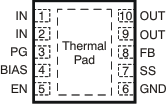ZHCSP78A december 2022 – may 2023 TPS748A-Q1
PRODUCTION DATA
- 1
- 1 特性
- 2 应用
- 3 说明
- 4 Revision History
- 5 Pin Configuration and Functions
- 6 Specifications
- 7 Detailed Description
- 8 Application and Implementation
- 9 Device and Documentation Support
- 10Mechanical, Packaging, and Orderable Information
5 Pin Configuration and Functions
 Figure 5-1 DRC Package,10-Pin VSON With Thermal Pad(Top
View)
Figure 5-1 DRC Package,10-Pin VSON With Thermal Pad(Top
View)Table 5-1 Pin Functions
| PIN | TYPE | DESCRIPTION | |
|---|---|---|---|
| NAME | VSON | ||
| BIAS | 4 | I | Bias input voltage for the error amplifier, reference, and internal control circuits. Use a 1-µF or larger input capacitor for optimal performance. If IN is connected to BIAS, a 4.7-µF or larger capacitor must be used. |
| EN | 5 | I | Enable pin. Driving this pin high enables the regulator. Driving this pin low puts the regulator into shutdown mode. This pin must not be left unconnected. |
| FB | 8 | I | Feedback pin. This pin is the feedback connection to the center tap of an external resistor divider network that sets the output voltage. This pin must not be left floating. |
| GND | 6 | — | Ground |
| IN | 1, 2 | I | Input to the device. Use a 1-µF or larger input capacitor for optimal performance. |
| NC | N/A | — | No connection. This pin can be left floating or connected to GND to allow better thermal contact to the top-side plane. |
| OUT | 9, 10 | O | Regulated output voltage. A small capacitor (total typical capacitance ≥ 2.2 μF, ceramic) is needed from this pin to ground to assure stability. |
| PG | 3 | O | Power-good pin. An open-drain, active-high output that indicates the status of VOUT. When VOUT exceeds the PG trip threshold, the PG pin goes into a high-impedance state. When VOUT is below this threshold the pin is driven to a low-impedance state. Connect a pullup resistor (10 kΩ to 1 MΩ) from this pin to a supply of up to 6.0 V. The supply can be higher than the input voltage. Alternatively, the PG pin can be left unconnected if output monitoring is not necessary. |
| SS | 7 | — | Soft-start pin. A capacitor connected on this pin to ground sets the start-up time. If this pin is left unconnected, the regulator output soft-start ramp time is typically 200 μs. |
| Thermal pad | — | Must be soldered to the ground plane for increased thermal performance. Internally connected to ground. | |